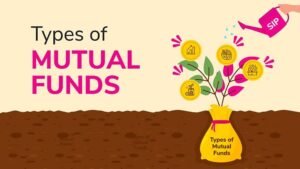Stocks, mutual funds, and ETFs are well-known ways of investing each with its own features. Stocks mean owning shares in individual companies, while mutual funds and ETFs combine assets into multiple securities. Mutual funds have professional management, but ETFs usually track market indexes.
Knowing the differences between investing in stocks vs mutual funds is important for making better investment choices that fit your financial goals and risk tolerance.
Stocks

Stocks represent owning part of a company and are traded on exchanges like the New York Stock Exchange (NYSE) and Nasdaq. Stocks give direct ownership to companies and stockholders can get dividends and voting rights based on the stock type.
Common stocks are the most common, while preferred stocks have priority dividends and asset claims. Stocks become tradable after an initial public offering (IPO) of a company, bought or sold via brokers. Stocks have features such as, potential high returns, voting power, and dividends, but also higher risks and volatility as compared to other investments.
Advantages of Investing in Stocks
Investments in stocks has some big benefits, including:
- Potential for high returns – Historically, stocks have produced higher long-term gains than other investments like bonds or savings accounts.
- Voting power and dividends As an owner, you might have a say in company choices and get dividend payments when profits are distributed.
- Total control over investment choices With individual stocks, you choose which companies to invest in and when to trade, letting you match your portfolio with your goals and values.
- Liquidity Stocks can mostly be easily bought and sold on exchanges, providing more liquidity than some other investments.
- Ownership Buying stocks gives you an ownership stake in the company.
Drawbacks of Investing in Stocks
When looking at stock investments, it’s key to know the possible downsides:
- Higher Volatility – Share prices can shift dramatically, causing big losses quickly. Market fluctuations can cause anxiety for new investors.
- More Research Needed Doing well in stocks requires nonstop research, analyzing trends and company performance. This time commitment is substantial.
- Lack of diversification Owning just a few stocks exposes you to focused risk. If one firm does wrong, it disproportionately impacts its portfolio.
- Potential for Big Losses – Unlike some investments, stocks carry the risk of losing your whole investment if a company fails.
- Emotional Decisions – Desire for fast profits or fear of losses can lead to rash choices that hurt long-term goals.
Mutual Funds

Mutual funds are investment instruments that combine resources from many investors to buy a diverse portfolio of securities, like stocks, bonds, or other assets. They are controlled by professional fund managers who make choices on behalf of investors.
Mutual funds give investors access to a wide range of assets, professional management, and potential diversification benefits. Investors purchase shares in the fund, with investment value tied to underlying asset performance. Mutual funds price once daily after market close, and investors are able to buy or sell shares via the fund company or broker.
Types of Mutual Fund

Mutual funds come in various categories, each with distinct goals, compositions, and risk levels. The main mutual fund types are:
- Equity Funds – Equity funds primarily invest in stocks seeking capital growth. Further divided depending on market cap (large-cap, mid-cap, and small-cap), investment style (growth, value, and blend), or sector (technology, healthcare).
- Bond Funds These funds are also called fixed income funds. Invest in bonds and debt securities for regular payouts and lower risk than stocks. They are categorized by the types of bonds they invest in, like government, corporate, and high-yield bonds.
- Money Market Funds – Invest in short-term and higher liquid debt like Treasury bills and commercial paper, prioritizing capital preservation and liquidity. Good for short term investment goals.
- Balanced Funds Balanced funds are also hybrid funds. Invest in a mix of stocks and bonds to balance growth and income. The asset value between equity and debt varies by investment strategy and risk tolerance.
- Index funds Seek to match the performance of a particular market index, like the S&P 500, by investing in the same securities and in the same amount as the index.
Advantages of Mutual Funds
Mutual funds have several key upsides for investors, which are:
- Expert Management – Mutual funds are handled by seasoned professionals who research, analyze, and make decisions. This saves investors effort while accessing expert strategies.
- Diversification By investing widely across companies, industries and asset types, mutual funds help spread risk. This can help mitigate the loss caused by a single bad investment in the overall portfolio.
- Accessibility Mutual funds often have low investment costs, making them available to more investors. They conveniently let you invest in a diverse portfolio without buying individual securities.
- Variety Funds come in types like equity, bonds, balanced, and index that cater to different goals and risk comforts. This variety lets investors choose what fits their individual needs.
ETFs (Exchange-Traded Funds)

ETFs combine the features of mutual funds and individual stocks into investment units. They are baskets of assets trading on stock exchanges daily, like individual stocks. ETFs typically track a specific index, sector, commodity or other asset, giving investors exposure to diverse portfolios in one transaction.
Unlike mutual funds priced once after market close, ETFs can be bought and sold at fluctuating market prices throughout the day. This allows investors to use trading strategies that involve limit orders and short selling.
ETFs let investors access a wide range of assets, including stocks, bonds, commodities and even cryptocurrencies. They can be used for various goals, from long-term wealth building to short-term trades.
Types of ETFs
ETFs have many types, each designed to track certain assets, sectors, or strategies. The main ETF categories are:
- Passive ETFs (Index-tracking) – Passive ETFs aim to match the performance of a particular market index, like the S&P 500 or NASDAQ composite. They hold securities closely matching the underlying index.
- Active ETFs These ETFs are managed by professionals to beat a benchmark index, unlike passive ETFs. They may have higher fees than passive ETFs.
- Sector ETFs – Focus on sectors like technology, healthcare, and energy. They allow investors to target specific industry exposure.
- Commodity ETFs: Commodity ETFs invest directly in gold, oil, agriculture products etc. They provide a way to diversify portfolios and hedge inflation.
- Bond ETFs – Hold various government, corporate, and high-yield bonds. Offer fixed-income securities exposure and steady income.
- Leveraged & Inverse ETFs – Use derivatives to amplify returns (leveraged ETFs) or profit from market declines (inverse ETFs). Considered high-risk short-term trading instruments.
Advantages of ETFs
ETFs have several key upsides for investors, which are:
- Lower Fees ETFs tend to have lower expense ratios versus actively managed mutual funds since they passively track an index.
- Trading Flexibility – can buy or sell ETFs throughout the day like stocks. They are allowing more liquidity and the use of limiting orders, stopping orders, and short selling.
- Tax Efficiency Due to their structure and lower turnover, ETFs are typically more tax efficient than mutual funds, with fewer capital gains distributions.
- Transparency – Most ETFs disclose holdings daily, so investors know exactly what they own to make informed decisions.
Key Differences Between Stocks, Mutual Funds, and ETFs
The given table shows the difference between investing in stocks vs mutual funds/ETFs, which are:
| Feature | Stocks | Mutual Funds | ETFs |
| Ownership | Direct ownership in individual companies | Indirect ownership of many securities through the fund | Indirect ownership of many securities that track an index |
| Diversification | Low, unless you buy many individual stocks | High, as funds hold many securities | High, as ETFs hold many securities |
| Management | Self-directed by the investor | Professionally managed by fund managers | Passively managed to track an index |
| Pricing | Prices fluctuate throughout the trading day | Priced once per day after market close (NAV) | Prices fluctuate throughout the trading day |
| Trading | Bought and sold anytime during trading hours | Traded once per day after market close | Bought and sold anytime during trading hours |
| Minimum Investment | Price of one share | Often has a minimum initial investment amount | Price of one share |
| Fees and Expenses | Commission fees for trades | Expense ratios, loads, and other fees | Lower expense ratios than actively managed mutual funds |
| Taxes | Capital gains tax on profits when sold | Capital gains distributions and taxes | More tax-efficient due to lower turnover and different structure |
Picking the Best Investment Option
When weighing stocks vs mutual funds/ETFs to invest in, look at:
- Investment Goals Figure out your short and long-term money objectives.
- Risk Tolerance – Gauge your comfort with market fluctuations as well as losses.
- Timeline – Consider how long you’ll hold the investments.
- Diversification Evaluate if you want concentrated or diversified holdings.
- Management Style – Decide if you prefer active or passive index tracking.
- Costs Compare expense ratios, trading fees, and other costs.
- Tax implications factor into the tax efficiency of each option.
- Liquidity – Assess how fast you may need the money.
The right choice depends on your personal situation and preferences. Many investors do best by combining stocks, mutual funds and ETFs.
Conclusion:
Investing in stocks vs mutual funds has different features, pros, and cons. Stocks present possible high yields and control but have more risk and instability. Mutual funds and ETFs offer diversity, professional handling and ease, but may charge fees and offer less control.
Ultimately, the best option depends on your goals, risk tolerance and preferences. A balanced portfolio regularly mixes these investment types.


